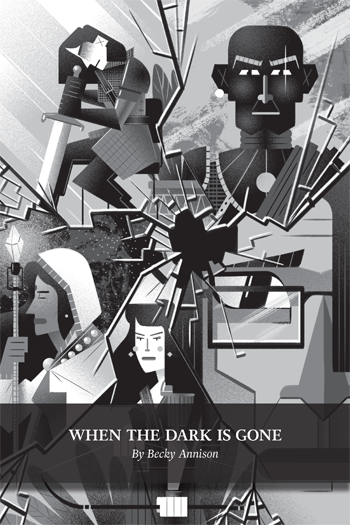News, Seven Wonders
When the Dark is Gone – a design process
by Becky Annison
It all started with Fiasco, a game by Jason Morningstar. Until then I’d loved and played many traditional games but nothing like Fiasco. It had no GM, required no pre-game prep and everyone created bits of the world and story. I’d never see anything like it before!
The idea of no prep and no GM was intriguing for a busy lawyer also studying for a Masters degree. Could I still have a satisfying gaming experience without hours of prep?
But as intriguing as it was, something troubled me. I struggled to imagine how a short game with no prep could reach the depths of emotional engagement I loved about traditional campaign play. Could I really get deep into a character in a game like this? This was the inspiration I needed to take me from player, GM and occasional LARP writer to RPG designer. If a short, prepless yet deeply emotional game did not exist (to my limited knowledge!) then I would simply have to write it. I was skeptical at the time – was what I wanted even possible?
The first hurdle was simple. Fiasco was designed for a completely different style of game. It is tragic-comedy, over-the-top and at times, farcical – just like the Cohen Brothers films on which it is based. A more serious topic, a therapy setting where players create troubled and hurting people would be a short cut for a deeper experience of character.
But then came the challenge. It is difficult for one individual to carry the weight of improvising all the material external to the player characters in any game e.g. the background, story, world building and non-player characters. A GM falling to improvise with sufficient speed, certainty and consistency damages the player’s ability to suspend disbelief and emotional buy-in to the world created. This is why traditional style games (game with a GM who directs all details of the world and story) tend to require large amounts of preparation. Prepless or low prep games tend to divide the work of improvising all this material (to greater or lesser extents) amongst all the players e.g. in Hillfolk by Robin Laws – scene set ups are described by each player rotating round the table (indeed there is an argument as to whether Hillfolk even needs a GM!), in Dream Askew by Avery McDaldno scene setting rotates around the table but each player also has responsibility and creative control over a different part of the world the characters inhabit, even in Vincent Baker’s Apocalypse World, the GM (or MC) is required to continually ask the players questions, getting them to define aspects of the setting which are then folded into the story by the MC.
There are many techniques and ideas out there for dividing creative control over the world, setting and story amongst multiple players. But they all held the same problem for my game. They all require the players to step out of character and think as a director or author of the story, rather than a participant in it. These are two very different mind states, often requiring different and occasionally contradictory agendas) I knew that in order to achieve deep character immersion in only 2-4 hours players would need to stay completely in character and that the culture of staying in character would need to be enforced by the group. In a traditional style game with a GM directing the story and the world, players can stay in character for the majority of a game, but even those games require players to refer to stats, roll dice or ask clarifying questions about the system and/or world. I wanted to dispense even with these out of character moments.
This gave me a number of problems to solve:
- How do you get the players to create details about the world and the story entirely in character?
- How do you maintain consistency and resolve conflicts entirely in character?
- How do you enforce a cultural norm in character?
The setting of a therapy session provided me with all the answers.
- The players create details in character because they are remembering something which has already happened. They cannot react to the things they create, except in so far they react to the memory of it having happened. Creating memories of a fantasy world as in When the Dark is Gone allows the players to have a lot of fun, but isn’t compulsory.
- You don’t bother with consistency or conflict resolution. Memory is fallible, people remember the same event differently all the time. If the memories created are inconsistent or conflict this it is brilliant – the characters can explore why their memories differ. It just creates more story.
- The last problem led to the creation of the Therapist character. Each session has a facilitator who is entirely in character as a Therapist. They ensure that interesting ideas get prompted and then explored by asking the players lots of in character questions. The Therapist constantly reinforces the in character culture and maintain the momentum and pacing of the session.
A surprising amount of the design for When the Dark is Gone went into the guidance for playing the Therapist. At first glance this might appear like a typical GM role. In fact it is very different. The Therapist has no creative input in the story at all – they are a true facilitator and yet it is a surprisingly satisfying role to play.
I’m pleased to say that in all the play testing rounds it was clear that When the Dark is Gone really produced a deeply emotional game, without prep and in a single session.
When the Dark is Gone is part of the Seven Wonders anthology by Pelgrane Press, available for pre-order here. I hope you enjoy playing it as much as I enjoyed writing it.



